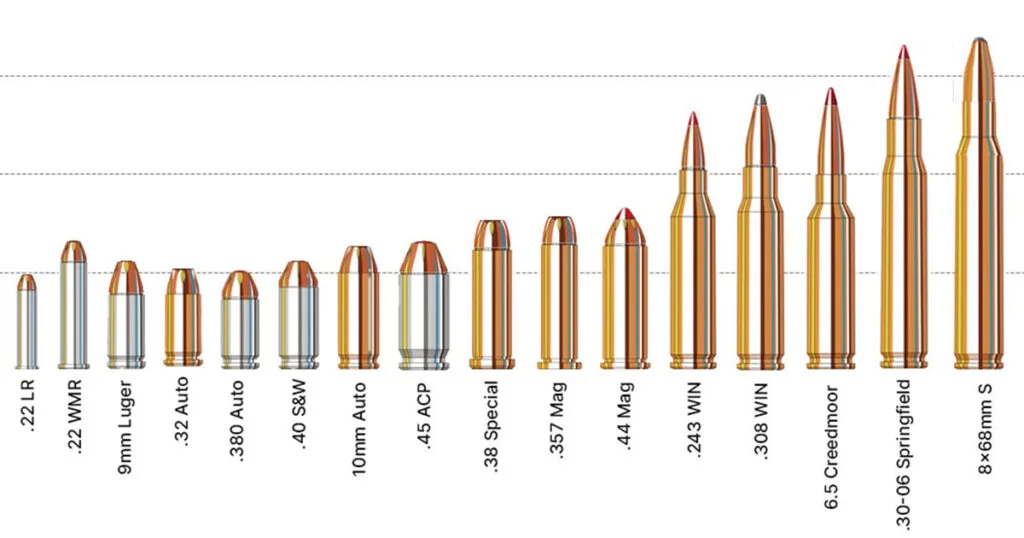When diving into the world of firearms, one of the first things you’ll notice is the vast array of ammunition types. One of the primary ways to categorize ammunition is by caliber, which refers to the diameter of the bullet or the internal diameter of the firearm’s barrel. In this guide, we’ll explore some of the most common calibers.

Image and content concepts from: Sportsman’s Warehouse
What is Caliber?
Simply put, caliber refers to the size of the bullet or the internal diameter of a firearm’s barrel. It can be expressed in inches (like .45 caliber) or millimeters (like 9mm). The term can sometimes be confusing because certain cartridge names might not directly correspond to the actual bullet diameter.
Before we get into common calibers, these are my picks for the Top 10 Most Used Ammo:
- 9mm – Widely used for personal defense and law enforcement.
- .22LR – Popular for target shooting and small game hunting.
- .45 ACP – Commonly used in many handguns for personal defense.
- .308 Caliber – Versatile rifle round used for hunting and target shooting.
- .380 ACP – Popular for concealed carry handguns.
- .40 S&W – Another popular choice for personal defense and law enforcement.
- .357 Magnum – Known for its stopping power in revolvers.
- .38 Special – A classic revolver round.
- 44 Magnum – Powerful round used for hunting and personal defense.
- .22 WMR – Used for varmint hunting and personal defense.
Top 10 Ammo Calibers by Size:
- .22LR
- .22 WMR
- 9mm
- .380 ACP
- .40 S&W
- .45 ACP
- .38 Special
- .357 Magnum
- .44 Magnum
- .308 Caliber
Common Calibers (smallest to largest)
For this section I’m just going from a .22LR to a .308.
- .22LR
- Bullet size: 30-40 grains
- Type: Rimfire cartridge
- Usage: Varmint < 50 lbs
- Velocity: 1,200-1,640 ft/s (40-30 gr)
- Energy: 131-191 ft⋅lbf (30-40 gr)
- Recoil: Low
- .22 WMR
- Bullet size: 30-50 grains
- Type: Rimfire
- Usage: Personal Defense
- Velocity: 1,530-2,300 ft/s (50-30 gr)
- Energy: 300-324 ft⋅lbf
- Recoil: Low
- 9mm
- Bullet size: 115-147 grains
- Type: Pistol
- Usage: Personal Defense
- Velocity: 1,180-2,010 ft/s (115-60gr)
- Energy: 355-501 ft⋅lbf (115-124gr)
- Primer type: Berdan or Boxer small pistol
- .380 ACP
- Bullet size: 45-100 grains
- Type: Pistol
- Usage: Personal Defense
- Velocity: 1,025-1,835 ft/s (100-45gr)
- Energy: 203-337 ft⋅lbf
- .40 S&W
- Bullet size: 105-200 grains
- Type: Pistol
- Usage: Personal Defense
- Velocity: 1,050-1,130 ft/s (200-165 gr)
- Energy: 468-490 ft⋅lbf (165-200 gr)
- .45 ACP
- Bullet size: 68-300 grains
- Type: Pistol
- Usage: Personal Defense
- Velocity: 835-2,036 ft/s (230-90 gr)
- Energy: 356-829 ft⋅lbf
- .38 Special
- Bullet size: 110-158 grains
- Type: Revolver
- Usage: Personal Defense
- Velocity: 900-1,150 ft/s (147-100 gr)
- Energy: 264-333 ft⋅lbf
- .357 Magnum
- Bullet size: 100-200 grains
- Type: Handgun; Carbine
- Usage: Varmint < 50 lbs; Medium Game 50-300 lbs; Personal Defense
- Velocity: 1,080-1,450ft/s (180-125 gr)
- Energy: 539-583 ft⋅lbf
- 44 Magnum
- Bullet size: 180-340 grains
- Type: Handgun; Rifle
- Usage: Medium Game 50-300 lbs; Large Game 300-1500 lbs; Personal Defense
- Velocity: 1,180-1,475 ft/s (340-240 gr)
- Energy: 741-1,533 ft⋅lbf
- Bullet diameter: .429 in (10.9 mm)
- Case length: 1.285 in (32.6 mm)
- Overall length: 1.61 in (41 mm)
- Primer type: Large Pistol
- .308 Caliber
- Bullet size: 100-240 grains
- Type: Rifle
- Usage: Large Game (300-1500 lbs); Dangerous Game
- Velocity: 2,510-3,100 ft/s (185-125 gr)
- Energy: 2,588-2,668 ft⋅lbf
- Recoil: Moderate
- Bullet diameter: 0.308 in (7.8 mm)
- Case length: 2.015 in (51.2 mm)
- Overall length: 2.800 in (71.1 mm)
- Primer type: Large rifle
Bullet Grain and Size
- Bullet size can differ within the same cartridge.
- .308 rifle bullets range from about 125 to over 185 grains.
- 9mm Luger bullets vary between 60 and 160 grains.
- AR-15 ammo typically uses a standard 55-grain bullet.
Bullet Weight’s Influence on Shooting
- Bullet weight affects trajectory, terminal ballistics, target impact, and recoil.
- For close-range target shooting, bullet weight is less critical.
- Lighter bullets are generally faster and maintain a flatter trajectory.
- Wind affects lighter bullets more than heavier ones.
Recoil and Bullet Weight
- Recoil is a direct result of physics: every action has an equal and opposite reaction.
- Heavier bullets usually produce more recoil.
- Recoil is influenced by factors like firearm weight and cartridge load.
- For target practice, lighter bullets (with less recoil) are often preferred.
Choosing Bullet Weight
- A larger cartridge and heavier bullet deliver more energy to the target.
- Heavier bullets ensure better expansion, penetration, and takedown capability.
- In self-defense, stopping power is crucial, making heavier bullets a preferred choice.

Will`
Tuesday 23rd of January 2024
I'm surprised that 5.56mm or .223 caliber aren't in the top 10... interesting.
SirDreams
Monday 4th of March 2024
@Will`, I have to agree with the .223 but not really the 5.56mm